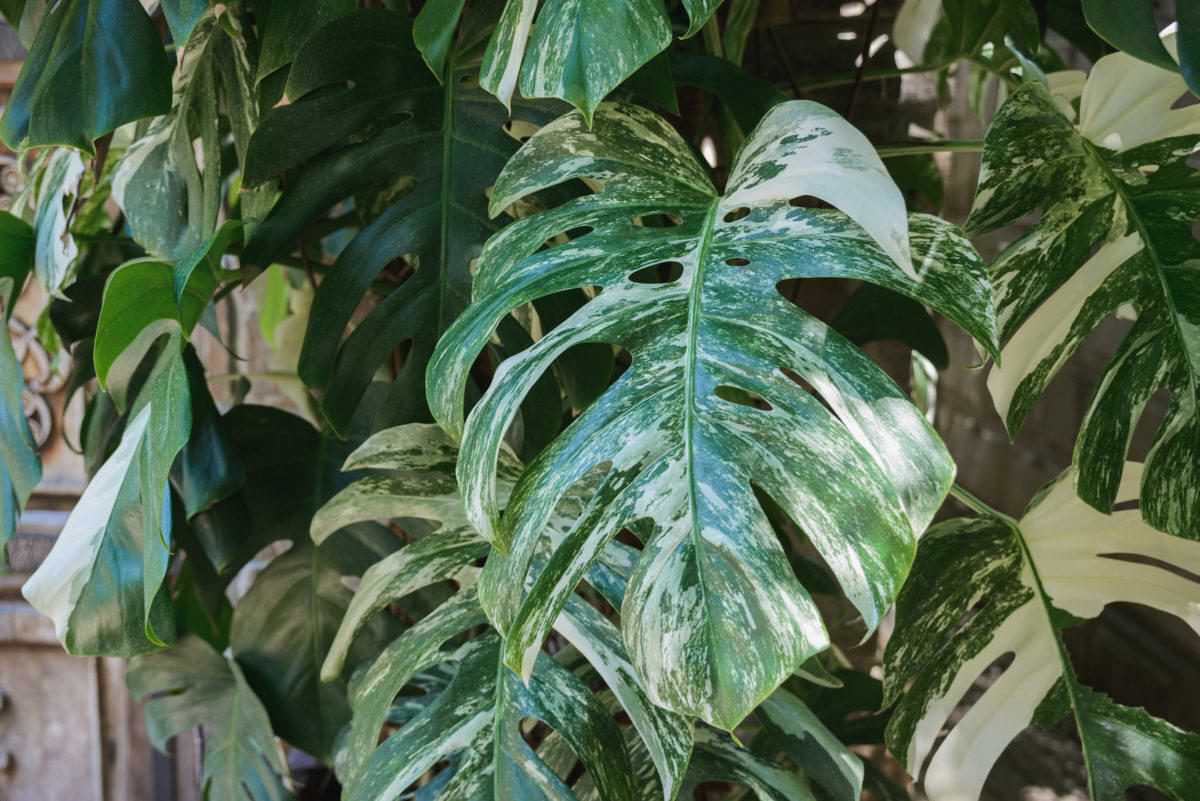If you’ve been a monstera fan for a while, you’ve probably seen stunning variegated monstera varieties on Instagram, Pinterest, and other social media. And if you’re anything like us, you’re probably in love with them!
If you’re new to monsteras or plant parenthood in general, variegation is when plant leaves and stems contain more than one color. A variegated plant may be green with stripes, spots, or splashes of a lighter color such as white, cream, yellow, silver, or lighter green. While this sometimes occurs in nature through mutation, almost all variegated plants you see in nurseries and online were created in labs through selective breeding and genetic modification.
These plants are extremely rare in nature because variegation, in most cases, is not an evolutionarily advantageous trait. Plants require chlorophyll, the substance that gives plants their green color, to carry out photosynthesis and convert sunlight into energy. White and cream-colored leaves, while beautiful, don’t do much to actually support the plant. So the green sections have to work overtime to support the highly variegated areas. It’s not the most energy-efficient system!
But variegated monsteras can do well as houseplants if they are provided with enough light. If you’re a diehard monstera fan who’s up for a challenge (but you’re not quite ready to dive into the search for a monstera obliqua), you might be ready for one of these breathtaking variegated monstera varieties.
Table of Contents
Monstera Deliciosa Variegata
This is the name for a naturally variegated monstera deliciosa plant. Unfortunately, it’s virtually impossible to grow one of these plants on purpose. These plants show up randomly through natural mutation in a regular monstera deliciosa and are therefore extremely rare. When this variegation does occur, the leaves and stems may exhibit green coloring with splashes, speckles, or even blocks of white, cream, or light green.
Monstera Deliciosa Thai Constellation
The Thai constellation is a modified monstera deliciosa variety with leaves similarly shaped to the classic monstera deliciosa. It’s named for the lab in Thailand that created it, and this lab supplies plants to buyers all around the world. This is the most common variegated monstera variety you’ll see on social media—and for good reason! It’s absolutely beautiful, featuring stunning stripes and speckles of white and cream alongside dark green.
You can sometimes find cuttings of this plant through private online sellers, but most specimens will ship straight from Thailand. This is not a budget houseplant, but it is a visually striking one!
Monstera Deliciosa Borsigiana, aka Monstera Albo
Monstera borsigiana is a monstera deliciosa subspecies that tends to mutate more often and display the variegation that so many of us covet! The leaves are slightly smaller than the true deliciosa, but this plant grows faster. You can tell the difference between this and the true deliciosa by looking at the stem where it attaches to the leaf. The true deliciosa has “ruffles” on either side of the stem that you won’t see on a borsigiana.
These plants also more readily retain their variegation when propagated from cuttings, which makes them far easier to find than a variegated monstera deliciosa. These plants can’t be grown from seeds (because, like the Thai constellation, monstera albo seeds don’t exist), so you’ll only find them as cuttings or full plants, and most likely only from private sellers and not in gardening stores or online shops. You can also expect to pay a pretty penny for a cutting and an arm and a leg for a mature plant, if you can find one at all!
But these plants are absolutely gorgeous and a great challenge for a true monstera fan.
Monstera Adansonii Variegated
If you’re a fan of monstera adansonii (also called monstera monkey mask), good news! You can sometimes find cuttings of the variegated version through private online sellers, and it’s absolutely lovely, often developing blocks of cream and white among the dark green.
Caring for Variegated Monstera Varieties
Care for these plants the same as you would their non-variegated counterparts, but take special care to provide plenty of light. If you don’t have a very bright room where your variegated monstera can get lots of indirect sunlight, you’ll need to supplement with grow lights.
Use a peaty, fast-draining soil, a pot with drainage, and a liquid fertilizer formulated for monsteras. Water when the top 2-3 inches of soil are dry or when a moisture meter reads 3-4. You’ll also want to provide your variegated monstera with a moss pole or trellis it can climb.
For more monstera care tips, don’t miss these posts:
How to Care for a Monstera Indoor Plant
Using Indoor Plant Supports With Monstera Plants
How to Buy and Care for Monstera Adansonii
How to Grow and Propagate a Variegated Monstera (webinar)
Variegated monstera varieties are significantly harder to find than their solid-green cousins, and they’re also more expensive and more difficult to care for, but helping one thrive can be extremely satisfying. And there’s nothing more eye-catching in a space than a stunning variegated monstera! If you can find one, give it a try!





